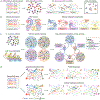Graph representation learning in biomedicine and healthcare
- PMID: 36316368
- PMCID: PMC10699434
- DOI: 10.1038/s41551-022-00942-x
Graph representation learning in biomedicine and healthcare
Abstract
Networks-or graphs-are universal descriptors of systems of interacting elements. In biomedicine and healthcare, they can represent, for example, molecular interactions, signalling pathways, disease co-morbidities or healthcare systems. In this Perspective, we posit that representation learning can realize principles of network medicine, discuss successes and current limitations of the use of representation learning on graphs in biomedicine and healthcare, and outline algorithmic strategies that leverage the topology of graphs to embed them into compact vectorial spaces. We argue that graph representation learning will keep pushing forward machine learning for biomedicine and healthcare applications, including the identification of genetic variants underlying complex traits, the disentanglement of single-cell behaviours and their effects on health, the assistance of patients in diagnosis and treatment, and the development of safe and effective medicines.
© 2022. Springer Nature Limited.
Figures




References
Publication types
MeSH terms
Grants and funding
LinkOut - more resources
Full Text Sources
Other Literature Sources
Medical

